 |
 |
||||||||||||||
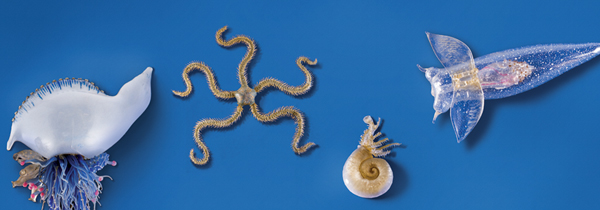
Return of the Mollusks
Lost treasures of nineteenth-century glasswork have found their way back from oblivionLate in life, P.T. Barnum, the showman and frequent Tufts benefactor, donated to the university two dozen glass models of marine invertebrates. Handcrafted by Leopold and Rudolf Blaschka—the German father and son team who made Harvard’s famous Glass Flowers collection—the specimens were lifelike in the extreme. The Blaschkas fashioned all the parts themselves, attached every tiny tentacle or filament with glue, and painstakingly applied paint. Then they sold the models to biology classrooms around the world. By nineteenth-century standards, their work was state of the art.
But the state of the art changed. Science found ways to preserve real squids, jellyfish, and their soft-bodied ilk, and glass replicas fell out of fashion. Eventually, Tufts’ collection was lost—incinerated in the fire that destroyed Barnum Hall in 1975. Or so everyone thought.
Enter Andrew McClellan, professor of art history and dean of academic affairs for Arts and Sciences. While researching a book on Jumbo in the Tufts archives, McClellan came across a letter written in 1965 by Russell Carpenter, then curator of specimens in Barnum Hall. It was addressed to the Corning Museum of Glass, in upstate New York. Would the museum please take some of the sea creatures on loan, for safekeeping, the letter asked. “When I came across the letter, no one at Tufts had any recollection of the transaction,” says McClellan.
Crossing his fingers, McClellan called Corning. The museum’s response was cordial but not encouraging. In the years since 1965, the museum had had its own disaster, a flood that damaged much of its collection and documentation. The long-lost models would have had little hope of surviving.
But soon there was good news: not only had the specimens survived, but the museum’s conservator, Stephen Koob, had volunteered to restore them. Koob drove down to Tufts in December 2007 to hand-deliver the sparkling, refurbished set. “It was rather an exciting moment,” says McClellan.
The sea creatures from Corning—along with the rest of the Tufts collection, which, in serendipitous fashion, surfaced in 2008 in a supply cabinet in the Dana Laboratory building—went on display at Tisch Library before being retired to the safety of the archives. Alonso Nichols, a prize-winning staff photographer at Tufts, has documented the Blaschka collection in a series of close-ups, including the ones we show here.
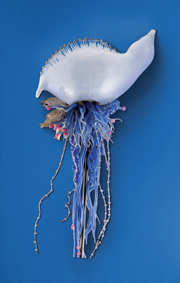
PORTUGUESE MAN O’ WAR (Physalia physalis). This stinging invertebrate consists of four separate organisms, including the sail that gives it its name. |
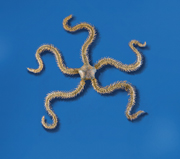
BRITTLE STAR (Ophiocoma rosula). Its whiplike arms can reach two feet in length and are used for crawling across the sea floor. Also known as serpent star. |
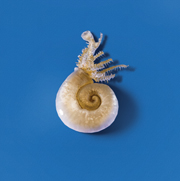
FEATHER DUSTER WORM (Sabellidae). A shell-building worm that extends its feathery tentacles to catch food. |
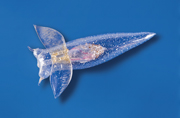
SEA ANGEL (Clione limacina). An inch-long transparent creature whose wings flap rhythmically for propulsion. |
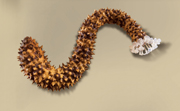
SEA CUCUMBER (Echinodermata). Its leathery skin is made of “catch collagen,” which can be changed from solid to liquid at will. |
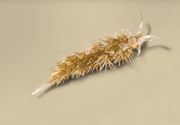
SEA SLUG (Favorinus albus). One of many species of nudibranchs. |
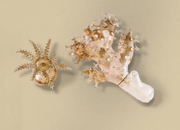
SOFT CORAL (Alcyonium stellatum). The individual polyps (shown in the enlarged model at right) form colonies attached to stones. |
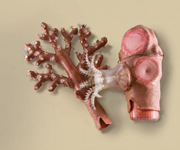
RED CORAL (Coelenterata). The familiar coral prized by jewelry makers worldwide. |

SEGMENTED WORM (Annelida). Some of its appendages are modified as gills. |

SEA HARE (Aplysia). An ink-releasing sea slug that grows up to a foot long. |

FLATWORM (Platyhelminthes). A simple worm that absorbs oxygen and nutrients through diffusion, and hence does not require circulatory or respiratory organs. |
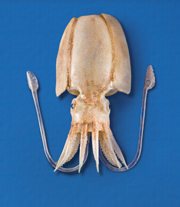
CUTTLEFISH (Sepiida). This relative of the octopus is among the most intelligent invertebrates. Its two long tentacles contain serrated suckers for snagging prey. |
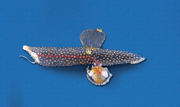
FLOATING SEA SNAIL (Carinaria mediterranea). The fin on top—a modified foot—is what propels this centimeter-long snail. |
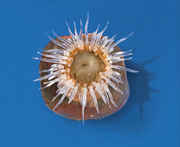
SEA ANEMONE (Actiniaria). Microfilaments in the sticky tentacles contract when touched, drawing prey toward the mouth. |
ALONSO NICHOLS shoots for a variety of Tufts publications. His work has appeared in the Boston Globe, Harvard’s Revista Magazine, La Nación newspaper (Costa Rica), and Argentina: From the Ruins of a Dirty War, a Tufts Institute for Global Leadership/de.Mo publication. HELENE RAGOVIN is a senior writer in Tufts’ Office of Publications, covering the School of Arts and Sciences for the online Tufts Journal. In her print newspaper days, she was recognized for editorial and column writing by the New Jersey Press Association. |